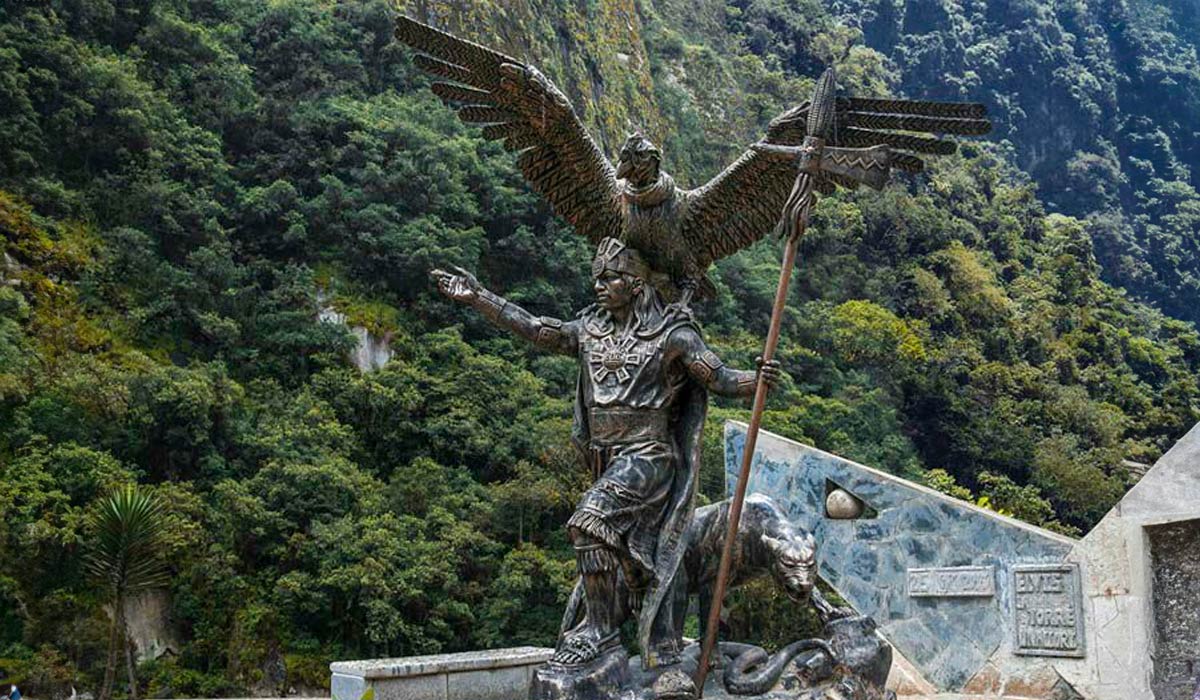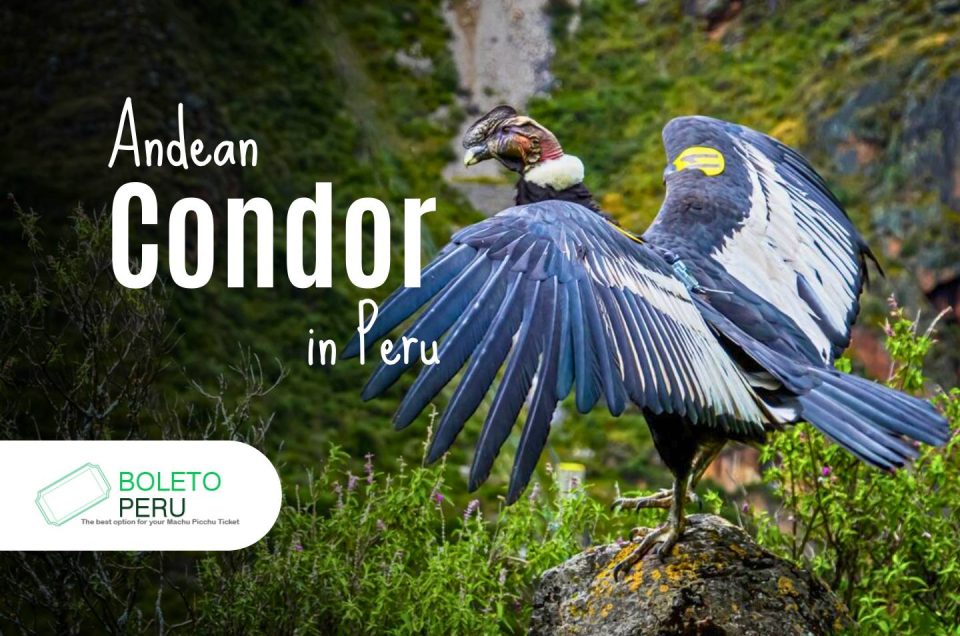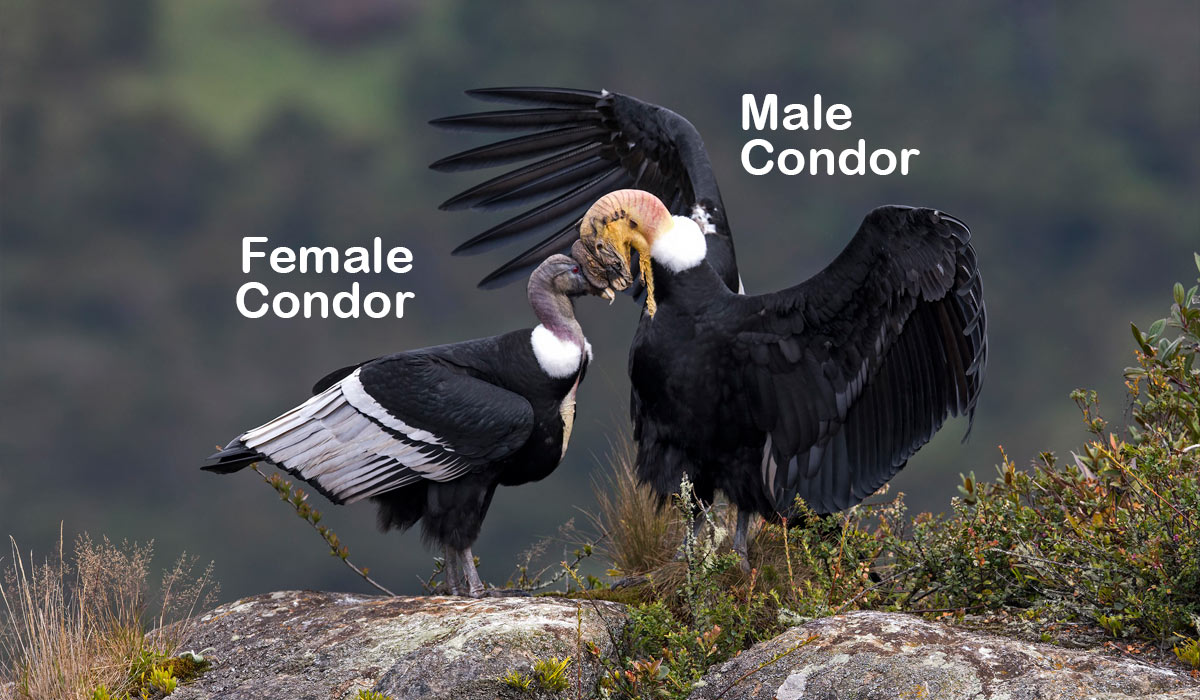The Andean Condor (Vultur gryphus) is one of the largest flying birds on the planet and the largest in Peru. It is a large scavenger bird, recognizable by its mostly black feathers, a clear white feather collar at the base of the neck and, in males, white patches on the wings. Its head and neck have no feathers and are a reddish color, a key adaptation for its hygiene.
In the Peruvian context, the condor goes beyond its biological importance; it is a cultural symbol. Since ancient times, it has been a central animal in the mythology and traditions of the Andean world, for the Inca civilization, the condor was considered a messenger of the gods, the representation of the Jananpacha (the world above or the sky) and a symbol of power and immortality, forming part of the sacred Andean trilogy along with the puma and the serpent.
While the condor’s habitat stretches along the entire Andes Mountains, from Colombia and Ecuador to Bolivia and Chile, Peru remains one of the most emblematic places for its observation. Currently classified as a “Vulnerable” species, the sighting of the condor in its natural environment, like in the Colca Canyon, has become one of the most sought-after experiences by visitors. This guide will analyze the key facts about this bird and the best places to observe it in the country.
The Meaning of the Condor for the Incas
For the Inca civilization, the condor, called Kuntur in Quechua, was one of the most sacred birds and a fundamental pillar of their culture. It was not seen simply as an animal, but as the messenger of the gods, the embodiment that connected the earthly world (Kay Pacha) with the heavenly world (Hanan Pacha).
This deep reverence endures today; many Andean towns still consider it a sacred animal, and its cultural importance is shown in mixed celebrations like the Yawar Fiesta (Festival of Blood) in some regions of Peru, where the condor plays a central role.

Key Facts about the Andean Condor
- Wingspan and Size: It has the largest wingspan of any land bird, reaching up to 3.3 meters (10.8 feet) with wings spread. An adult male can weigh up to 15 kg.
- Identification: It is easy to tell males and females apart. The male is larger, has a fleshy crest (caruncle) over its beak, and its eyes are brown. The female does not have a crest and her eyes are a distinct red color.
- Ecological Role: It is a strict scavenger, playing a vital role in cleaning the ecosystem. Its strong beak is adapted to tear the thick skin of large animals, such as guanacos, cattle, or marine fauna.
- Flight Technique: It is a master glider. It uses its excellent eyesight (not smell) to locate carrion from great heights. Its large size prevents it from flapping its wings constantly, so it depends on thermals (columns of hot air) to rise and glide for hours with minimal energy use.
- Reproductive Cycle: Its reproduction rate is extremely low, which makes it a vulnerable species. It is monogamous (has one partner for life) and reaches sexual maturity late (after 5 to 8 years). It lays a single egg every 2 or 3 years, and both parents incubate and care for the chick.
- Seasonal Migration: Although it mainly lives in the mountain range, at certain times of the year (like in the southern spring), some populations descend to the Pacific coast, especially in southern Peru, to feed on the carrion of sea lions and other marine species.
- Cultural Symbol: Besides its importance in the Inca worldview (as mentioned before), the Andean condor is a national symbol in several countries. It is present on the national shields of Bolivia (representing the search for horizons), Chile (strength), Colombia (freedom), and Ecuador (power and courage).
- Classification: It belongs to the Cathartidae family (New World vultures). The family name comes from the Greek word kathartes, which means “the one who cleans”.
Ecological Role and Conservation
The Andean condor fulfills a fundamental ecological function as a scavenger. According to specialists from the Wildlife Conservation Society (WCS), by feeding on dead animals, the condor speeds up the decomposition process. This significantly reduces the risk of spreading diseases associated with the slow decay of carrion, maintaining the sanitary balance of its ecosystem.
This species’ habitat is vast and extends from the desert coast of the Pacific, where it occasionally descends to feed on marine fauna, to the highest peaks of the Andes Mountains. It is an expert glider that uses thermals to ascend to great altitudes, easily reaching 7,000 meters above sea level to patrol its territory in search of food.
Despite its cultural and ecological importance, the Andean condor is currently classified as a “Vulnerable” species globally and in “Danger” in Peru, facing threats from poisoning, hunting, and the reduction of its habitat. However, its observation in the wild has become a pillar for nature tourism in the country.
Condor sighting, managed sustainably (like in the Colca Canyon), generates direct income for local communities. This ecotourism model creates an economic incentive for the active protection of the bird and its environment, showing that the conservation of the species is compatible with local development.
Characteristics of the Andean Condor Bird
The Andean condor is a species that stands out both for its unique physical characteristics and for its complex social and reproductive behavior. Here we present its characteristics, its behavior and life cycle of this bird:
Physical Characteristics
- Wingspan and Weight: It is one of the largest flying birds on the planet. Its wingspan (distance from wingtip to wingtip) can reach 3.3 meters. Adult males are heavier, and can reach 15 kg.
- Plumage: The plumage of adults is mostly black, with a distinct collar of white down at the base of the neck. Males also usually have white patches on the upper part of the wings. Young specimens, on the other hand, have brown or brownish plumage, which darkens to black as they mature.
- Sexual Dimorphism (Differences): Unlike many birds of prey, the condor shows clear sexual dimorphism. Males are larger than females and have a fleshy crest (caruncle) over the beak, as well as folds on the neck. Females lack this crest and their eyes are a distinct red color, while the male’s are brown.
- Head and Neck: The head and neck of both sexes lack feathers. This is a fundamental biological adaptation for their hygiene, as it prevents bacteria and remains of carrion from sticking to the skin when feeding.
Behavior and Life Cycle
- Longevity and Vulnerability: They are extremely long-lived birds, with a life expectancy that can exceed 50 years in the wild and more than 70 in captivity. This longevity is linked to a very low reproduction rate, which makes their populations very vulnerable to threats.
- Reproduction: Condors are monogamous, meaning they keep the same partner for life. They build simple nests on hard-to-reach cliffs or caves. The female lays only one egg every two or three years. Both parents share the incubation, which lasts between 54 and 58 days, and the chick is cared for by both for more than a year before becoming independent.
- Social Behavior: Although they are soaring birds that usually search for food alone, they have a gregarious social behavior. It is common to see them in groups to feed on the same carrion or to rest together in “roosting sites” (cliffs designated for spending the night).
Condor Habitat
The habitat of the Andean condor covers the entire Andes Mountain Range, with a distribution that goes from the north in Colombia and Venezuela to the southern tip of Patagonia in Chile and Argentina. It is a bird of open and mountainous areas, preferring the puna and high-altitude plains, which allow it to soar and visually patrol its territory.
In Peru, although its historical distribution includes a large part of the highlands, the most important populations and the most accessible observation points are found in the south. The best-known destination for sighting them is the Colca Canyon, in the Arequipa region. Populations can also be found in Apurímac, Ayacucho, Cusco and other Andean regions, as well as in areas of the desert coast where it descends to feed on marine fauna.
Feeding of the Andean Condor
The diet of the Andean condor is strictly scavenger. It fulfills a fundamental ecological role by cleaning the ecosystem of carcasses, which helps prevent the spread of diseases.
It is a common mistake to think that the condor locates its food by smell. Unlike other vultures (like the turkey vulture), the Andean condor does not have a developed sense of smell. It locates carrion exclusively through its sharp eyesight, soaring thousands of meters high for hours to visually scan vast territories. It feeds mainly on the carcasses of large animals, both wild (guanacos, vicuñas) and domestic (livestock, sheep), or on marine fauna (like sea lions) in the coastal areas to which it migres seasonally.
Where to See It?
To observe the Andean condor in its natural habitat, the most reliable places are deep canyons, where they use the thermal air currents to fly. The most famous and accessible observation point in all of Peru is in the Arequipa region: the Mirador de la Cruz del Cóndor, in the Colca Canyon. This place is part of the standard tourist itinerary and offers a high probability of seeing the birds gliding at a short distance, especially during the mornings. In the Cusco region, the main destination is the Mirador de Chonta (Apurimac Canyon), an alternative that has gained popularity and offers a similar experience with fewer tourists.
Besides these specific viewpoints, it is possible (although not guaranteed) to spot condors during several of the main hiking routes in the region. The Choquequirao Trek is one of the most favorable for this, as the trail descends into the Apurimac Canyon, the same habitat where Chonta is located. Likewise, on the Salkantay Trek, hikers often report sightings when crossing the high mountain pass (Abra Salkantay, 4,630 m), where the birds glide on the air currents.
Other high-altitude routes, like the Inca Trail Trek 4 Days (specifically at the Warmiwañusca pass) and the hike to the Rainbow Mountain (in the puna at 5,000 m), also offer the possibility of timely sightings, as they are part of the vast territory that these birds patrol. Although the Sacred Valley is at an altitude that is too low to be a reliable observation point, it serves as a logistical base for many of these expeditions, like the tours that combine Rainbow Mountain to Machu Picchu.
In Danger of Extinction
The Andean condor faces serious threats to its survival. In Peru, it is officially classified as a species “In Danger of Extinction”, according to Supreme Decree No. 004-2014-MINAGRI, and is legally protected by the Peruvian State. Internationally, the International Union for Conservation of Nature (IUCN) lists it as “Vulnerable”, and it is protected by CITES (Convention on International Trade in Endangered Species of Wild Fauna and Flora).
The main causes of the decrease in its population are directly related to human conflict. The most serious threat is poisoning from toxic carrion. This often happens indirectly, when ranchers use poison on cattle carcasses to control predators (like pumas), and the condors, being scavengers, ingest the poison and die.




